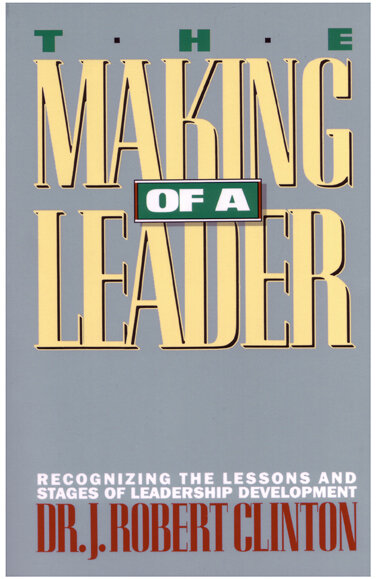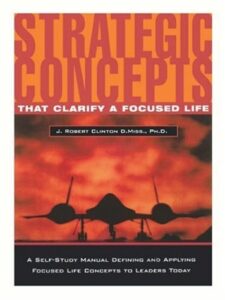Introduction
Robert Clinton was a long time professor at Fuller Theological Seminary. Each of the following volumes explains a feature of his Leadership Emergence Theory (see Ministry Resource Guide on the subject).
Six works either explain Clinton’s theory or present tools for helping leaders assess themselves in light of the theory.
- The Making of a Leader
- Strategic Concepts that Clarify a Focused Life
- Leadership Emergence Theory
- Unlocking Your Giftedness
- Connecting: The Mentoring Relationships You Need
- Conclusions on Leadership Styles
Clinton also self-published a companion series of Leadership Commentaries on biblical characters, demonstrating leadership principles from their life stories. Click here to find a complete listing.
The Main Volumes:
 Foundation – J. Robert Clinton, The Making of a Leader: Recognizing the Lessons and Stages of Leadership Development. NavPress, 1988.
Foundation – J. Robert Clinton, The Making of a Leader: Recognizing the Lessons and Stages of Leadership Development. NavPress, 1988.
This is one of the most fascinating studies on leadership by Bob Clinton, long time professor at Fuller Theological Seminary. If any leader wants to assess how God is at work in his or her life, become more attentive to God’s leading, and give attention to important developmental tasks, this is an excellent tool. Clinton’s model grows out of his research of hundreds of Christian leaders, most notably men like A.W. Tozer, Watchman Nee, and Dawson Trottman. He extracts from their lives five, or in some cases six, developmental phases that leaders undergo as their lives unfold. Leaders may not experience all five or six phases, and there may be overlap, but the overall concept of the stages holds. The generalized time-line of the stages is summarized in chapter two:
Sovereign foundations — God providentially works to lay the foundations of the leader’s life through family, environment, and historical events.
Inner-Life Growth — The leader comes to know God in a more intimate, personal way. He is tested. If he learns from these experiences what God wants to teach, it results in expanded ministry and greater responsibility. If he does not learn, he will usually be tested again in the same areas.
Ministry Maturing — The leader reaches out to others, experimenting with spiritual gifts, and may get training. He becomes a rising leader, learning lessons in his relationships with others or from the inadequacies of his personal life.
In these first three phases, God’s work is primarily in the leader, not through him or her. Many emerging leaders do not recognize this, and become frustrated. They are constantly evaluating productivity and activities, while God is quietly evaluating their leadership potential. He wants to teach us that we minister out of what we are. (45-46)
Life Maturing — The leader identifies and uses his or her spiritual gifts in a satisfying ministry. Priorities are clearer for identifying the best use of gifts, what to do and not to do, resulting in mature fruitfulness. The leader’s character mellows and matures. Communion with God becomes more important than success in ministry, and the leader’s character mellows and matures. The key to development in this phase is a positive response to the experiences God ordains.
Convergence — God maximizes the leader’s ministry by moving him or her into a role that matches one’s gift-mix and experience and that is comparatively freed from less suited activities. Convergence may not come either for lack of personal development, or an organization keeps him or her in a limiting role, or providence hinders in a way difficult to understand without the full picture that only God sees. Reaching this phase requires trust in God’s guidance and watching as God moves one toward a ministry that embodies all the development of preceding phases. Convergence manifests itself as one responds consistently to God’s work in his life.
Afterglow or Celebration (for only a few) – A lifetime of ministry and growth culminates in an era of recognition and indirect, broad influence. Leaders continue to exert influence in these relationships through a large network of contacts built over a lifetime. Their consistent track record in following God causes others to seek out their storehouse of wisdom.
Clinton says:
As a leader, you should recognize that God is continually developing you over a lifetime. His top priority is to conform you to the image of Christ for ministry with spiritual authority. Enduring fruitfulness flows out of being. In addition to transforming your character, God will increase your capacity to influence through developing your spiritual gifts. (54)
In chapters 3-7, Clinton discusses each developmental phase in depth. Chapters 8-9 discuss how leaders integrate and accept the lessons of life. The appendix lays out summary observations on leadership emergence and selection. The book is full of biblical and historical illustrations, summary charts, exercises, and a glossary.
 Companion volume – J. Robert Clinton, Strategic Concepts that Clarify a Focused Life: A Self-Study Manual Defining and Applying Focused Life Concepts to Leaders Today. Barnabas Publishers, 2005.
Companion volume – J. Robert Clinton, Strategic Concepts that Clarify a Focused Life: A Self-Study Manual Defining and Applying Focused Life Concepts to Leaders Today. Barnabas Publishers, 2005.
This was originally published in 1995 and then updated and revised in 2005. It is an excellent companion to The Making of a Leader. Here Clinton concentrates on the role of life focus in eight highly effective Christian leaders who finished well: Charles Simeon, A. J. Gordon, Samuel Brengle, G. Campbell Morgan, Robert Jaffray, R. C. McQuilkin, Henrietta Mears, and L. E. Maxwell. From his study, Clinton arrived at this definition of a focused life:
a life dedicated to exclusively carrying out God’s unique purpose through it, by identifying the focal issues, that is the life purpose, unique methodology, major role, or ultimate contribution which allows and increasing prioritization of life’s activities around the focal issues, and results in a satisfying life of being and doing.
He discusses how each of these develops over four periods of adult life: ages 30-40, ages 40-50, ages 50-60, and age 60+. During each of these age spans, a leader will experience a tentative Personal Life Mandate that becomes increasingly more firm over time, and that may be revised several times. This book functions as a manual for leaders to define the focused life, assess the focused life, and proactively move toward the focused life. Typical of Clinton, the reading can be a bit thick and technical, but it is a very worthy read. Most outstanding Christian leadership coaches today are quite aware of this volume, and make good use of it. The bibliography and research methodology behind Strategic Concepts may be found in the companion volume, Focused Lives: Inspirational, Life Changing Lessons From Eight Effective Christian Leaders Who Finished Well. Barnabas Publishers, 1995.
go to top
Supportive Works:
J. Robert Clinton, Leadership Emergence Theory: A Self-Study Manual for Analyzing the Development of a Christian Leader. Barnabas Publishers, 1989. This is a dense, 460-page manual explaining the theory and research behind Clinton’s The Making of a Leader. It is only for those who really want to know more about the theory. It focuses on the three major factors that God uses to shape Christian leaders: processing, time, and leader response patterns.
 J. Robert Clinton and Richard W. Clinton, Unlocking Your Giftedness: What Leaders Need to Know to Develop Themselves and Others. Barnabas Publishers, 1993.
J. Robert Clinton and Richard W. Clinton, Unlocking Your Giftedness: What Leaders Need to Know to Develop Themselves and Others. Barnabas Publishers, 1993.
This resource helps leaders recognize the need to develop themselves and others. This self study manual gives the most complete treatment of giftedness on the market. It treats the whole giftedness set-natural abilities, acquired skills, and spiritual gifts. It views giftedness from the standpoint of a leader responsible for developing self and others. Notice especially the sub-title. This book clarifies and suggests developmental means. Concepts flow from accumulated research on leaders since 1983.
J. Robert Clinton and Paul D. Stanley, Connecting: The Mentoring Relationships You Need. NavPress, 1992. Here Clinton and Stanley discuss the crucial role that mentors play in leadership development, especially in helping one overcome the five most common reasons for failure. They discuss nine different types of mentors within three categories: 1) Intensive mentoring – discipler, spiritual guide, and coach; 2) Occasional mentoring – counselor, teacher, and sponsor; and 3) Passive Mentoring – contemporary modeling, historical modeling, and divine contacts. They also cover peer mentoring. This is a very helpful guide to assessing the network of mentors one needs, how to find them, and how to respond to them so as to reap the greatest benefit. A self-study manual on the same subject, appropriate for small groups or individual study is The Mentor Handbook (Barnabas Publishers, 1991). One may also be interested in The Mentoring Reader, a the free series of informative articles on mentoring written by Clinton from 1999-2005.
J. Robert Clinton, Conclusions on Leadership Styles. Barnabas Publishers, 1986. Clinton examines different leadership style theories and considers how various styles can impact the life of an organization. He presents the major theorists up to the date of publication (1986) such as Blake and Mouton, Fiedler, Hersey and Blanchard. He explains their views, and then synthesizes the basic tenets into a set of concepts which can inform a Christian leader today. Includes insights from the Scriptures regarding Pauline leadership styles.
See Other Resources on Leadership Development:
See Resources on Over 100 Ministry Topics:
